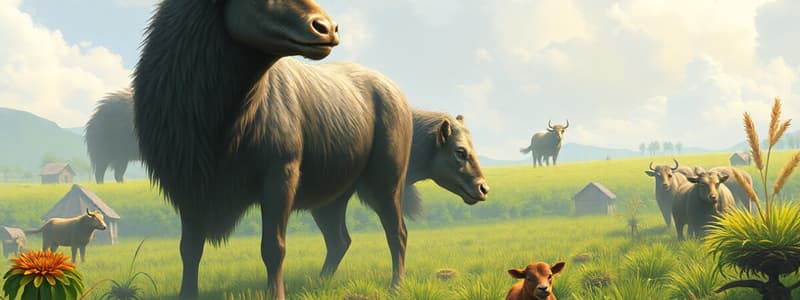Podcast
Questions and Answers
What animal immigrants had a significant impact on agriculture in the Americas?
What animal immigrants had a significant impact on agriculture in the Americas?
- Fish and birds
- Elephants and camels
- Cattle and horses (correct)
- Cats and dogs
How did the introduction of horses affect indigenous peoples in North America?
How did the introduction of horses affect indigenous peoples in North America?
- It encouraged sedentary farming lifestyles.
- It decreased their hunting efficiency.
- It allowed them to become better bison hunters. (correct)
- It eliminated political structures.
What was one economic impact of the new animals introduced to the Americas?
What was one economic impact of the new animals introduced to the Americas?
- Led to the extinction of native species.
- Reduced trade between communities.
- Increased economic specialization and production levels. (correct)
- Decreased agricultural output.
What type of conflicts arose as a result of the new animals in the Americas?
What type of conflicts arose as a result of the new animals in the Americas?
Which crops thrived in the Americas due to the Columbian Exchange?
Which crops thrived in the Americas due to the Columbian Exchange?
What was a social consequence of the Columbian Exchange in the Americas?
What was a social consequence of the Columbian Exchange in the Americas?
Which crop became a plantation crop in the Americas worked mainly by enslaved Africans?
Which crop became a plantation crop in the Americas worked mainly by enslaved Africans?
Which of the following was a major benefit of animal introduction in terms of transportation?
Which of the following was a major benefit of animal introduction in terms of transportation?
What impact did new crops have on American agriculture?
What impact did new crops have on American agriculture?
What was a significant change in the Americas due to the Columbian Exchange?
What was a significant change in the Americas due to the Columbian Exchange?
From which region did coffee originate before becoming a plantation crop in the Americas?
From which region did coffee originate before becoming a plantation crop in the Americas?
Which crop is described as having suited soil and climate conditions from Ireland to Russia, resulting in population growth?
Which crop is described as having suited soil and climate conditions from Ireland to Russia, resulting in population growth?
What was one of the primary causes of the dramatic population decline in Guam's Chamorro people?
What was one of the primary causes of the dramatic population decline in Guam's Chamorro people?
What is the primary significance of maize in Atlantic Africa after 1550?
What is the primary significance of maize in Atlantic Africa after 1550?
Which of the following plants and animals were introduced to Guam?
Which of the following plants and animals were introduced to Guam?
Which of the following crops did NOT originate in the Americas?
Which of the following crops did NOT originate in the Americas?
How did the introduction of maize affect lands around the world?
How did the introduction of maize affect lands around the world?
What was the main result of the transpacific exchanges following Magellan's voyages?
What was the main result of the transpacific exchanges following Magellan's voyages?
How did the demographic consequences of diseases introduced to Pacific islands compare to those in Eurasia?
How did the demographic consequences of diseases introduced to Pacific islands compare to those in Eurasia?
Which of the following was NOT a crop introduced from Eurasia to the Americas?
Which of the following was NOT a crop introduced from Eurasia to the Americas?
What significant biological changes occurred in the Pacific islands during the 18th and 19th centuries?
What significant biological changes occurred in the Pacific islands during the 18th and 19th centuries?
What type of contact led to the historical decline of the aboriginal Australians after 1788?
What type of contact led to the historical decline of the aboriginal Australians after 1788?
What was one impact of the intercontinental biological exchange between 1492 and 1800?
What was one impact of the intercontinental biological exchange between 1492 and 1800?
Which disease was NOT mentioned as contributing to the decline of the Chamorro population?
Which disease was NOT mentioned as contributing to the decline of the Chamorro population?
What was a significant outcome of oceanic voyaging for the islands of the Pacific and other coastal regions?
What was a significant outcome of oceanic voyaging for the islands of the Pacific and other coastal regions?
Which European group's understanding of oceanic winds and currents allowed them to dominate long-distance trade?
Which European group's understanding of oceanic winds and currents allowed them to dominate long-distance trade?
What was one main consequence of the spinning of the first truly Global web?
What was one main consequence of the spinning of the first truly Global web?
What characterized societies that were isolated and had few connections to the Old World web?
What characterized societies that were isolated and had few connections to the Old World web?
How did Zheng He's voyages between 1405 and 1433 impact historical linkages?
How did Zheng He's voyages between 1405 and 1433 impact historical linkages?
In what way did Atlantic Europeans influence world history after 1492?
In what way did Atlantic Europeans influence world history after 1492?
What roles did the new long-distance trade possibilities offer to the first European sailors?
What roles did the new long-distance trade possibilities offer to the first European sailors?
What pathogens were isolated societies particularly vulnerable to due to their lack of prior exposure?
What pathogens were isolated societies particularly vulnerable to due to their lack of prior exposure?
What was a primary cause of the population decline in many archipelagoes?
What was a primary cause of the population decline in many archipelagoes?
What was the general trend in indigenous population sizes in the Americas and Oceania after initial European contact?
What was the general trend in indigenous population sizes in the Americas and Oceania after initial European contact?
How did the biological exchange between 1492 and 1800 impact global demographics?
How did the biological exchange between 1492 and 1800 impact global demographics?
What effect did improved nutrition have on global population between 1500 and 1800?
What effect did improved nutrition have on global population between 1500 and 1800?
Which process contributed to the recovery of indigenous populations, albeit slowly?
Which process contributed to the recovery of indigenous populations, albeit slowly?
What was one of the major benefits of the surge in biological exchange?
What was one of the major benefits of the surge in biological exchange?
Which of the following crops is prominently associated with global food systems due to biological exchange?
Which of the following crops is prominently associated with global food systems due to biological exchange?
What led to increased mortality and suppression of fertility among indigenous populations?
What led to increased mortality and suppression of fertility among indigenous populations?
Flashcards are hidden until you start studying
Study Notes
The Impact of Animals in the Americas
- Eurasian and African animals, like cattle, goats, sheep, pigs, and horses, thrived in the Americas.
- These animals provided new sources of food, hides, wool, and transportation.
- The introduction of horses dramatically altered the political landscape of North America, leading to the rise of powerful equestrian groups like the Sioux and Comanche.
The Columbian Exchange and Key Crops
- Eurasian crops like wheat, rye, barley, and rice flourished in the Americas.
- The Columbian Exchange also introduced citrus fruits, grapes, figs, millets, sorghums, yams, bananas, okra, and watermelon to the Americas.
New Drug Crops in the Americas
- Sugar, originally from New Guinea, became a major plantation crop in Brazil and the Caribbean.
- Coffee, from Ethiopia and Arabia, emerged as another crucial plantation crop in the 18th century.
The Americas' Contributions to Global Cuisine
- The Americas introduced staple crops to the world, including maize, potatoes, sweet potatoes, cassava, tomatoes, cacao, peanuts, pumpkins, squashes, pineapples, and many more.
- Potatoes had a significant effect on Europe's population growth.
- Maize (corn) became a primary food source in many parts of the world, including China, Southern Europe, and, most notably, Africa.
The Pacific Islands and Guam
- The Columbian Exchange spread to the Pacific Islands, causing drastic population declines due to introduced diseases.
- Guam experienced a 90% population decrease within a century, largely due to new diseases like smallpox, measles, and tuberculosis.
- Gum acquired new plants and animals, including cattle, hogs, chickens, rice, maize, citrus trees, and the tangantangan shrub.
Other Pacific Islands and Australia
- Other Pacific islands and Australia suffered similar population declines after contact with the wider world, primarily due to diseases.
- Aboriginal Australians faced severe impacts after 1788.
The Impact of Biological Exchange
- The Columbian Exchange led to significant demographic changes around the world, particularly in the Americas and Oceania.
- The introduction of new diseases to those regions resulted in dramatic population declines.
- These declines were also influenced by factors like the loss of land, enslavement, and forced migration.
Impact of Global Exchange on Nutrition
- The exchange of crops worldwide improved food resources globally, reducing the frequency of famine and disease, and ultimately leading to a surge in population growth.
Global and Local Webs
- The Columbian Exchange created a global exchange of food and biological resources, ultimately impacting local cuisines and cultures.
Studying That Suits You
Use AI to generate personalized quizzes and flashcards to suit your learning preferences.





